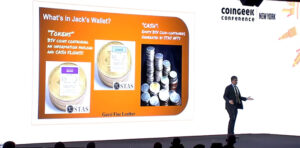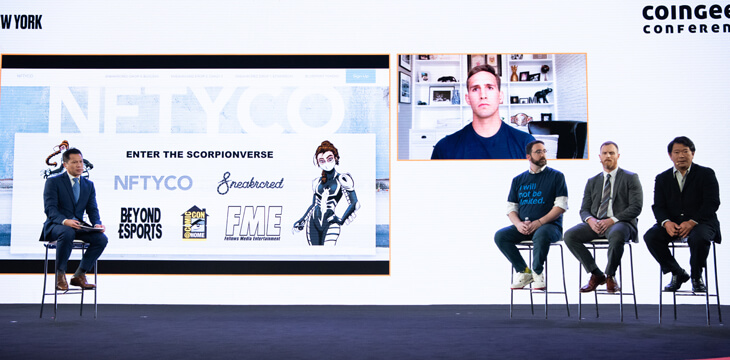|
Getting your Trinity Audio player ready...
|
By now we know what NFTs are (sort of), but what are they actually for? Sure they can be static collectibles, but those with a longer vision think they could—and should—be far more meaningful. SLictionary co-founder John Pitts presented his company’s NFTs as value-adding investments for future generations, while a panel including MMA fighter Rory MacDonald and other NFT industry participants looked at some current and potential uses.
In many ways, the current “art-based” NFT craze merely echoes other blockchain token crazes of the past—hastily-produced and low-quality products of little utility selling for inexplicable thousands or millions of dollars. Despite its façade of novelty, this craze is driven by the same “HODL” or “pump and dump” urges that has driven ICOs, altcoins, even BTC itself, for the past decade. Buyers buy for a shot of attention or in the hope they can sell to the Greater Fool later on. As Pitts and some of the CoinGeek New York participants noted, money laundering could also be a big motive.
Words and meanings for education… and profit
Pitts gave a classic Wall Street-style pitch for NFTs as digital real estate that owners could create, enrich and add value to over time—using the “properties” as a source of passive income and potentially even as inheritance for one’s descendants. SLictionary’s STAS tokens are “Layer One,” on-chain tokens forever embedded directly on the BSV blockchain.

He presented charts detailing the math, showing how a SLictionary “Wordsmith” could create words and definitions (you can make up a new word and define it, or “own” a better definition to an existing word). As regular users searched for words on the site they’d upvote and popularize those creations, increasing their value and paying out creators in dividends. You could earn over $1,000 a year and leave six-figure sums to your children after a few decades, he said.
Pitts added that SLictionary is an investment plan, property record repository and also a useful learning tool. “My wife runs a school, we’re using SLictionary for everything from first grade to fifth grade.” The BSV-based economic model also helps to improve the quality of internet content overall, a cluttered mess of ads and distractions he described as “a sewer.”
And everyone benefits. “There’s no hopium, no screwing the next guy … that makes happy people, it’s just commerce”, he said. Pitts’ speech shifted in tone from content quality improvement to investment pitch and back again, showing how tokenized immutable data on the BSV blockchain could solve a number of the world’s current problems.

A panel discussion that followed showcased a number of different, yet closely related, possibilities for NFTs. Rory MacDonald, a Bitcoiner since 2015, was less concerned with the hows and feature lists of NFTs than with their potential for celebrity-backed merchandising. It also put those famous faces—who would bring with them their massive fan bases—in greater control. “The NFT model puts the power in (their) hands, involves them more in the process,” he said. MacDonald added that he’s only interested in BSV, having followed its history through debates and forks, and saying “BSV is what I was exited about Bitcoin.”
Art, investing, celebrity experiences and events
Shawn Ryan, co-founder and CEO of SmartLedger, also wants to create NFTs that actually serve a purpose for their owners. His new project, called TicketMint, wants to take on the event ticketing industry with NFTs that contain not only event access permissions, but include collectible items from the event/artist and maybe some unique experiences as well (the first 100 could get a T-shirt, the first 10 could get a personal hello from the performing artist, etc.) Ticket issuers could exercise more granular control over whether a ticket could be re-sold and at what prices—a definite move away from pump-and-dumps, as well as scalping. He hopes artists and event managers will see the added appeal of NFT tickets and be tempted away from existing players that dominate the industry.
“We’re going to be gamifying fandom, in a way,” Ryan said.
Victor Tang of NiftyCo and Eric Bernhard of Fabriik Digital Objects talked about more familiar topics to those who’ve followed the NFT scene so far. Tang is creating a platform called “Mona” to deal in NFTs as “digital twins” to high value physical artworks that could include data on the works’ provenance and usage rights. Bernhard’s FabriikX platform is a trading market that promises deals with major celebrities and artists, but insists that works have “cultural relevance” and meaning, in an expert-curated environment.
Both expressed distaste at the current state of “NFT art” and the platforms on which it exists. The most popular (Ethereum-based) NFT market, OpenSea, “dilutes the brand” by being an open-to-everyone wild west of tokens based on hype (and possibly the money laundering motives) mentioned earlier.

All up, all the above speakers saw great potential in NFTs but were interested in creating actual value and quality. Only BSV, with its unbounded capacity to process and store data on chain, could offer quality NFT projects the features and security to do this properly. NFTs on other blockchains may have all the hype right now, but they’re ultimately flawed. They’re a disorganized mix of on-and-off-chain data with no guarantees the “asset” can even be retained, while scaling limits on those other chains ultimately lead to prohibitive costs and corner-cutting in the features an NFT can supply.
With SLictionary a few lines of text could become an enduring and even lucrative investment property, while art dealers and traders need a more reputable product to sell to their customers. For others, they can still be static collectibles with a few extra features. So what are NFTs actually for? Anything you can imagine—but these possibilities are only endless if their foundation is the BSV blockchain.
Watch CoinGeek New York 2021 Day 2 here:

 12-30-2025
12-30-2025 




